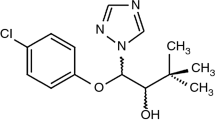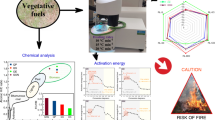Abstract
A study was conducted to explore the mechanism that emissions of volatile organic compounds (VOC) from heated needles and twigs (200°C, within 15 min) of Pinus pumila affect fire behaviours using the technology of Thermal Desorption — Gas Chromatography — Mass Spectrometry (TD-GC-MS). The results indicated that the main components of VOC from heated needles and twigs are terpenoids. Most of these terpenoids are monoterpenes. Terpenoids account for 72.93% for the needles and 92.40% for the twigs of the total VOC, and their emission ratios are 61.200 μg·g−1 and 217.060 μg·g−1 respectively. Heated twigs can emit more terpenoids than heated needles because twigs had more volatile oils than needles. In actual fires, these large amounts of terpenoid emissions, especially the monoterpene emissions, have strong effects on fire behaviors that are not only in the initial stage but also in the fast propagation stage of fires. These flammable gases are capable of causing violent combustion and creating crown fires. In addition, if these gases accumulate in an uneven geographical area, there will be a possible for eruptive fires and/or fires flashover to occur.
Similar content being viewed by others
References
Chen Cunji, He Zongming, Chen Donghua, Huang Yonglai, Xie Jinsheng. 1995. Studies on the fire-resistance of 37 species of coniferous and broadleaf trees and it’s appraisal. Scientia Silvae Sinicae, 31: 135–143. (in Chinese)
Chetehouna K, Barboni T, Zarguili I, Leoni E, Simeoni A, Fernandez-Pello AC. 2009. Investigation on the emission of volatile organic compounds from heated vegetation and their potential to cause an accelerating forest fire. Combustion Science and Technology, 181: 1273–1288.
Du Yongsheng, Wang Lifu. 2007. Forest fire cases in China. Beijing: China Forestry Publishing House, 124-125pp. (in Chinese)
Fan Weicheng. 1993. An Introduction to Fire Science. Hefei: Hubei Science and Technology Press, pp. 156–162 (in Chinese)
Granström K. 2003. Emission of monoterpenes and VOCs during drying of sawdust in a spouted bed. Forest Products Journal, 53: 48–56.
Greenberg JP, Friedli H, Guenther AB, Hanson D, Harley P, and Karl T. 2006. Volatile organic emissions from the distillation and pyrolysis of Vegetation. Atmospheric Chemistry and Physics, 6: 81–91.
Jiang Mengxia. 1982. A study on the growth and distribution of Pinus pumila in Daxing’anling Mountains. Scientia Silvae Sinicae, 18: 203–205. (in Chinese)
Jin Youju, Wu Jingke, Sun Fu, Deng Wenhong, Wang Hongju, Sun Wencheng. 1994. Terpene composition of needle oil from Pinus tabulae formis and the comparison with other two-needle pines. Journal of Beijing Forestry University, 16: 38–47. (in Chinese)
Maleknia SD, Bell TL, Adams MA. 2009a. Eucalypt smoke and wildfires: Temperature dependent emissions of biogenic volatile organic compounds. International Journal of Mass Spectrometry, 279: 126–133.
Maleknia SD, Vail TM, Cody RB, Sparkman DO, Bell TL, Adams MA. 2009b. Temperature-dependent release of volatile organic compounds of eucalypts by direct analysis in real time (DART) mass spectrometry. Rapid Communications in Mass Spectrometry, 23: 2241–2246.
Okitsu S. 1998. Distribution and growth of Pinus pumila regel along the Larix Gmelinii Rupr. timberline ecotone of Mt. Dal’nyaya Ploskaya, central Kamchatka. Proceedings of the NIPR Symposium on Polar Biology, 11: 159–168.
Okuda M, Sumida A, Ishii H, Vetrova VP, Hara T. 2008. Establishment and growth pattern of Pinus pumila under a forest canopy in central Kamchatka. Ecology research, 23: 831–840.
Ormeño E, Céspedes B, Sánchez IA, Velasco-García A, Moreno JM, Fernandez C, Baldy V. 2009. The relationship between terpenes and flammability of leaf litter. Forest Ecology and Management, 257: 471–482.
Owens MK, Lin CD, Taylor CA, Whisenant SG. 1998. Seasonal patterns of plant flammability and monoterpenes content in Juniperus ashei. Journal of Chemical Ecology, 24: 2115–2129.
Pompe A, Vines RG. 1966. The influence of moisture on the combustion of leaves. Australian Forestry Journal, 30: 231–241.
Shan Yanglong, Li Hua, Qi Qige. 2003. Experimental analysis of the burning and physicochemical property of principal species in Daxing’an Mountain Heilongjiang province. Fire Safety Science, 12: 74–78. (in Chinese)
Shu Lifu, Tian Xiaorui, Kou Jilie. 1999. Studies on fire resistant tree species of Dagui Mountains, Guangxi Zhuang Autonomous Region. Scientia Silvae Sinicae, 35: 69–76. (in Chinese)
Shu Lifu, Wang Mingyu, Tian Xiaorui, Li Zhongqi, Xiao Yongjun. 2003. The fire environment mechanism of lightning fire formed for Daxing’an Mountains. Scientia Silvae Sinicae, 39: 94–99. (in Chinese)
Wen Dingyuan, Shu Lifu. 1999. Theory of Forest Fire. Harbin: Northeast Forest University Press, pp. 21–27. (in Chinese)
White CS. 1994. Monoterpenes—their effects on ecosystem nutrient cycling. Journal of Chemical Ecology, 20: 1381–1406.
Xu Huacheng. 1998. China Daxing’anling Mountains Forests. Beijing: Science Press, pp. 15–16. (in Chinese)
Zedler PH. 1995. Are some plants born to burn? Trends in Ecology & Evolution, 10: 393–395.
Zhao Jing, Bai Yuhua, Wang Zhihui, Zhang Shuyu. 2004. Studies on the emission rates of plants VOCs in China. China Environmental Science, 24: 654–657. (in Chinese)
Author information
Authors and Affiliations
Corresponding author
Additional information
Foundation project: This work is supported by National Natural Science Foundation of China (30872037, 31070587), Open Project Program of State Key Laboratory of Fire Science, University of Science and Technology of China (HZ2008-KF08).
Rights and permissions
About this article
Cite this article
Zhao, Fj., Shu, Lf., Wang, Qh. et al. Emissions of volatile organic compounds from heated needles and twigs of Pinus pumila . Journal of Forestry Research 22, 243–248 (2011). https://doi.org/10.1007/s11676-011-0157-9
Received:
Accepted:
Published:
Issue Date:
DOI: https://doi.org/10.1007/s11676-011-0157-9




